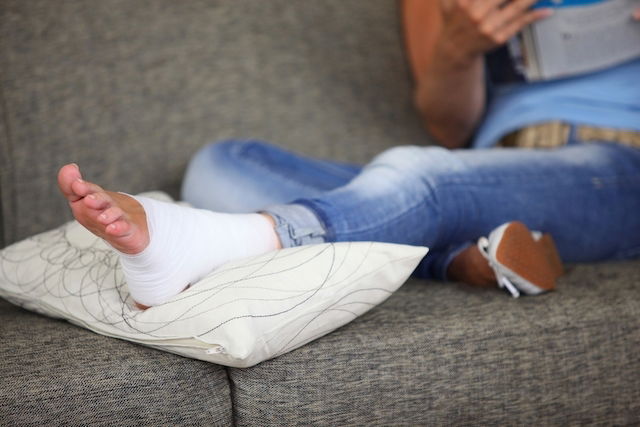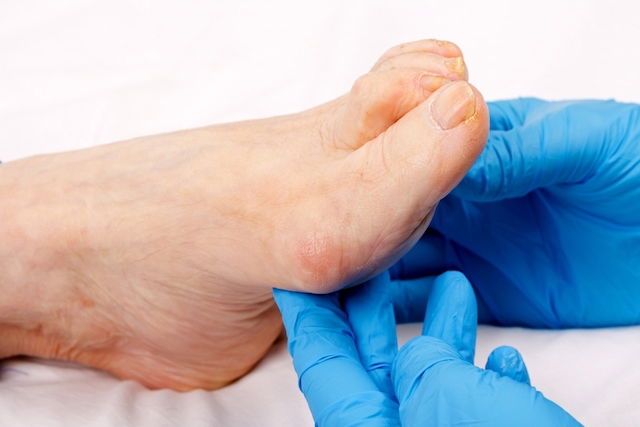Swollen feet and ankles are a common symptom and are generally not a sign of a serious problem. Swelling is usually associated with normal changes in circulation that can happen from being on your feet for too long, for example.
When feet stay swollen for more than a day, or if swelling comes with other symptoms like pain, intense redness or difficulty walling, it may be a sign of a more serious problem or injury, like a sprain, infection or even a clot.
In pregnancy, this symptoms is especially common and is related to changes in blood circulation. It is rarely a sign of a problem with the pregnancy.

Why causes foot and ankle swelling?
The 10 most common causes of swelling in the feet and ankles include:
1. Bad circulation in the legs and feet
This is the most common cause of swelling in the legs, feet or ankles. In adults, elderly or pregnant women, it is most experienced at the end of the day. Although bad circulation isn't painful, it can cause mild discomfort, like having heavy feet or fluid-filled feet.
Bad blood circulation in the legs is normal with aging, as veins become less capable of returning blood up to the heart. This causes blood to accumulate and pool in the legs.
What to do: To alleviate swelling, you should lie down and elevate your legs above heart level. Another option is to massage your legs from the foot up to the thighs, to help the blood return to the heart. People who stand for prolonged periods at work can use compression stockings to prevent this issue (these can be purchased at the pharmacy).
2. Sprain and other injuries
Any kind of sprain or trauma to the ankle can cause swelling as well as pain, difficulty in moving the foot, and bruising on the side of the foot. One of the most common ankle injuries is a sprain, which occurs when the foot is not placed properly on the foot and rolls over, or when the ankle suffers direct trauma.
With sprains, ankle and foot ligaments are overly stretched which can result in small tears. This leads to an inflammatory response that includes swelling, intense pain many times, bruising, and difficulty walking or moving the foot. Sprains can often be confused for a fracture, but they are usually occur more frequently.
What to do: It is important to apply ice following the injury and to immobilize and rest the entire foot. Avoid intense sports or prolonged walking for at least 2 weeks. Another strategy is to place the injured foot in a basin with hot water, and then in another basin with ice water, as this temperature change will help to reduce swelling quickly.
In more serious cases, surgery may be necessary to stabilize the joint with rods and screws. Several months of physiotherapy is usually necessary following surgery, as well as a follow-up procedure about a year later to remove the hardware.
3. Pre-eclampsia during pregnancy
Ankle swelling is a very common problem in pregnancy that is usually not related to any serious problems. However some cases of swelling may be a sign of high blood pressure, or pre-eclampsia. This can be accompanied by other symptoms like abdominal pain, decreased urination, headache or nausea. This condition requires immediate treatment.
What to do: If you suspect you have pre-eclampsia, you should have your blood pressure checked immediately. To prevent this condition during pregnancy, ensure you consume a low-salt diet with plenty of hydration (2-3L or 8-12 cups of water per day).
4. Cardiac insufficiency
Cardiac insufficiency is most common in older adults, and occurs to aging of the heart muscle. It becomes weaker and is unable to pump blood, which leads to blood pooling in the legs, ankles and feet.
Generally, older adults with swelling in the feet and ankles also experience excessive fatigue, shortness of breath, and pressure in the chest.
What to do: Cardiac insufficiency can be treated with prescription medication. You should be followed by a cardiologist to ensure you are receiving adequate treatment.
5. Liver failure and cirrhosis
Swelling in the ankles can also be a sign of liver failure or cirrhosis. Swelling can occur due to a reduced production of albumin, a protein that helps keep blood inside the vessels.
In addition to ankle swelling, swelling can also be noted in the feet or abdomen. Liver disease can also cause other symptoms such as yellowing of the skin and eyes.
What to do: It is important to consult a liver specialist, gastroenterologist or family doctor for a liver assessment, which may involve ordering bloodwork to check liver enzymes, bilirubin, alkaline phosphatase and gamma glutamyl transferase.
6. Nephrotic syndrome
Nephrotic syndrome is a kidney condition that is characterized by excessive protein loss in the urine. It can be caused by infections, such as HIV and hepatitis, or diseases such as diabetes and lupus.
Swelling caused by nephrotic syndrome can affect the ankles as well as other parts of the body, such as the feet, face and arms. It can also cause foamy urine, tiredness and loss of appetite.
What to do: if nephrotic syndrome is suspected, it is important to consult a general practitioner or nephrologist for a thorough assessment, as treatment varies depending on its cause
7. Thrombosis
A thrombosis occurs when a clot blocks a vein in the legs, which impedes blood from returning to the heart. Blood begins to accumulate in the legs, feet and ankles.
In these cases, in addition is lower leg swelling, you may also experience pain, tingling, intense redness and even a low-grade fever.
What to do: If you suspect you have a blood clot, you should proceed immediately to the emergency department to initiate anticoagulant therapy. This will prevent the clot from travelling to other places in the body, like the brain or heart, and causing a stroke or heart attack.

8. Liver or kidney problems
In addition to heart problems, abnormal functioning of the kidneys or liver can also cause swelling in the body, especially in the legs, feet and ankles.
With liver problems, swelling occurs due to a decrease in albumin, which is a protein that helps to keep blood within the vessels. With kidney problems, swelling occurs due to improper elomination of fluid through the urine.
What to do: If swelling occurs frequently and comes with other symptoms like decreased urine output, abdominal bloating or yellow skin or eyes, you should see your doctor. He or she may order blood or urine testing to evaluate whether the kidneys and liver are functioning properly.
9. Infection
Infection accompanied by foot or ankle swelling usually only occurs when there is a wound in this area that has been left untreated. This situation is more common is people with uncontrolled diabetes that suffer from lesions on their feet, but do not feel them due to loss of sensation.
What to do: If a diabetic has an infected wound that requires treatment, they should be seen immediately by their doctor. Until a consult is made, the wound should be cleaned and bandaged to prevent further bacterial growth.
10. Venous insufficiency
Swelling in the feet and ankles can also be a sign of venous insufficiency. This occurs when blood in the lower extremities has difficulty returning to the heart. All veins contain valves that help blood to flow back to the heart, even against gravity. However,when these valves are weakened and not functioning, blood flows backward and begins to accumulate in the legs and feet.
What to do: Venous insufficiency should be treated to prevent serious complications, like skin wounds and infection. A cardiologist or vascular surgeon may prescribe diuretics to eliminate excess fluid and other medication to strengthen blood vessels.
11. Cellulitis
Infectious cellulitis is a superficial skin infection that can occur on the legs, face, arms and other parts of the body. It is associated with symptoms such as pain, swelling and redness in the affected area.
What to do: if you suspect you may have infectious cellulitis, it is important to consult a doctor for assessment and diagnosis. If confirmed, treatment with antibiotics is usually started promptly.
12. Hypothyroidism
Hypothyroidism is a disease in which there is a change in the functioning of the thyroid that leads to a reduced production of thyroid hormones like T3 and T4. It is associated with symptoms such as excessive fatigue, decreased heart rate, weight gain, hair loss and, in In some cases, inflammation of the joints of the hands, legs and ankles.
What to do: if you suspect you may have hypothyroidism, you should see a doctor for bloodwork to check your thyroid hormone levels. If they are low, the doctor may advise hormone replacement therapy. Joint swelling or pain can be managed with anti-inflammatory medications may be recommended
13. Side-effect from a medication
Certain medications can also have swelling in the legs and feet as a side-effect. These include birth control, heart medication, steroids, corticoids, diabetes medication and antidepressants.
What to do: If you are taking a medication that is causing swelling, you should discuss your swelling with your doctor. Depending on how severe it is, the doctor may be able to swap your medication for an alternative that does not cause this side effect.
14. Lymphedema
Lymphedema is characterized by an accumulation of fluid in body tissue, outside of the blood vessels. It can occur due to removal of lymph nodes or an abnormality in the lymphatic system. This accumulation of fluid can be chronic, which makes it difficult to treat. It is particularly difficult after removal of lymph nodes in the groin, which can occur with cancer treatment, for example.
What to do: You should see your doctor to confirm a diagnosis. Treatment typically involves physiotherapy session, use of compression stockings and changing postural habits.
Swollen ankles during pregnancy
Ankle swelling is relatively common during pregnancy and is not always a sign of any serious problem. However, you should see a doctor if the swelling presents with abdominal pain, decreased urine output, headache, nausea, or high blood pressure, as it may be a sign of pre-eclampsia.
If you suspect you may be experiencing pre-eclampsia, you should seek urgent assessment
The type of doctor you should see
You should consult a cardiologist if a heart abnormality is suspected, however a family doctor is usually sufficient to make a diagnosis and start appropriate treatment. Physical exams and bloodwork can be done to assess for high cholesterol or triglycerides, for example, or imaging tests like x-ray, MRI or ultrasound may be necessary if a sprain is being evaluated. In an elderly older adult, all testing may be necessary to confirm and rule out many possibilities that could be present at once.
